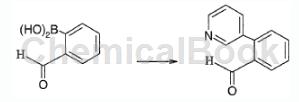Background and overview[1]
2-pyridin-3-ylbenzaldehyde can be used as a pharmaceutical synthesis intermediate. If 2-pyridin-3-ylbenzaldehyde is inhaled, move the patient to fresh air; if there is skin contact, take off contaminated clothing, rinse the skin thoroughly with soap and water, and seek medical attention if you feel uncomfortable; if the eye contact If exposed to sunlight, separate eyelids, rinse with running water or saline, and seek medical attention immediately; if ingested, rinse mouth immediately, do not induce vomiting, and seek medical attention immediately.
Preparation[1]
The preparation of 2-pyridin-3-ylbenzaldehyde can be divided into the following types:
Method 1: To 1-bromobenzaldehyde (250 μL, 2.14mmol), sodium carbonate (270mg, 2.55mmol) and 3-pyridineboronic acid (289mg, 2.35mmol) in 4.2mL N, N-dimethyl To a suspension in carboxamide/water was added palladium acetate (24 mg, 0.11 mmol) and triphenylphosphine (115 mg, 0.44 mmol). After stirring at 110°C overnight, the reaction mixture was filtered. The filtrate was diluted with chloroform, and the solution was washed with brine and dried over MgSO4. After filtration, the filtrate was concentrated in vacuo, and the residue was purified by silica gel column chromatography (chloroform/methanol=99/1→95/5). The title compound 2-pyridin-3-ylbenzaldehyde was obtained as a white powder 250 mg (yield 64%).
Method 2: To a solution of Pd(PPh3)4 (0.085g, 0.07mmol) in acetonitrile (6mL) under nitrogen, add water (2mL), then add 2-formylphenylboronic acid (0.55g, 3.68 mmol), 3-bromopyridine (0.36 mL, 3.68 mmol) and potassium carbonate (2.69 g, 22.07 mmol). After stirring at 60 °C for 3 days, the reaction mixture was purified by flash chromatography on silica gel, eluting with ethyl acetate/isohexane (10:90 to 30:70) to give the title compound 2-pyridin-3-ylbenzaldehyde, For oily substance. MS: [M+H]=184.

Main reference materials
[1](WO2005000811)3-AMINOPYRROLIDINESASINHIBITORSOFMONOAMINEUPTAKE

 微信扫一扫打赏
微信扫一扫打赏

